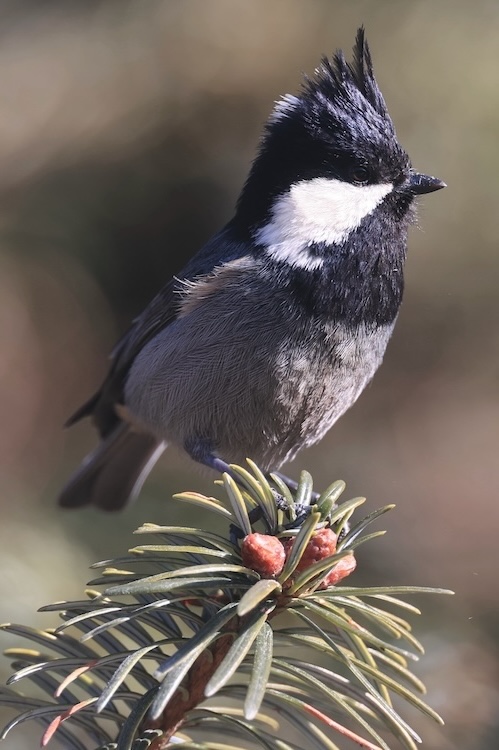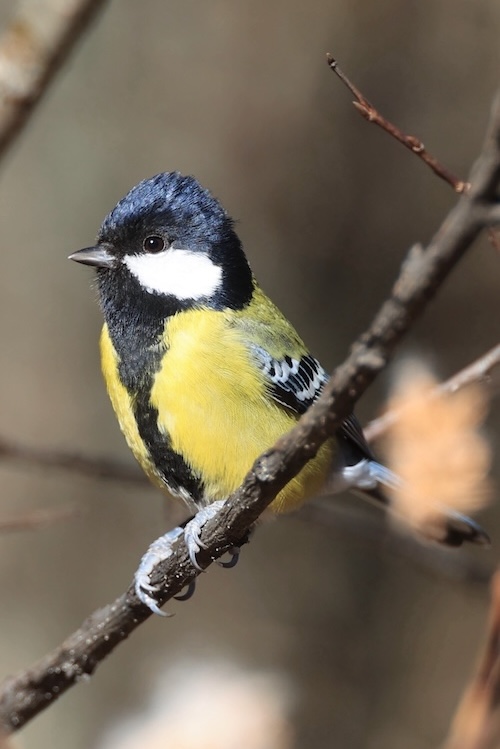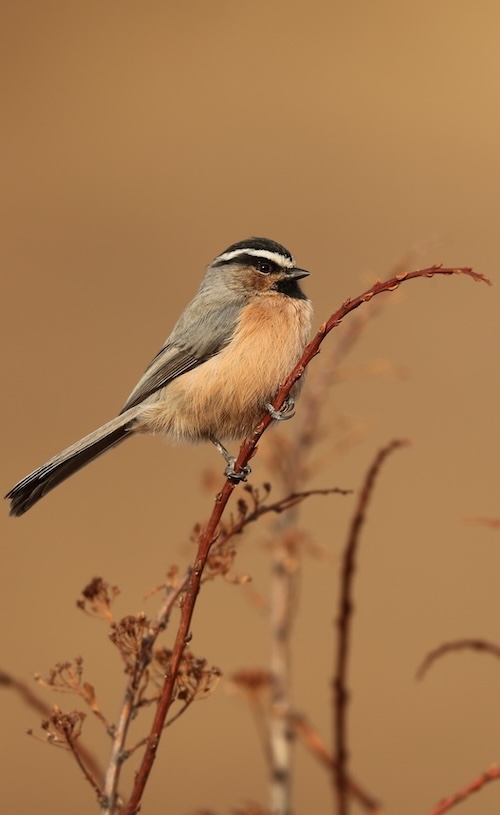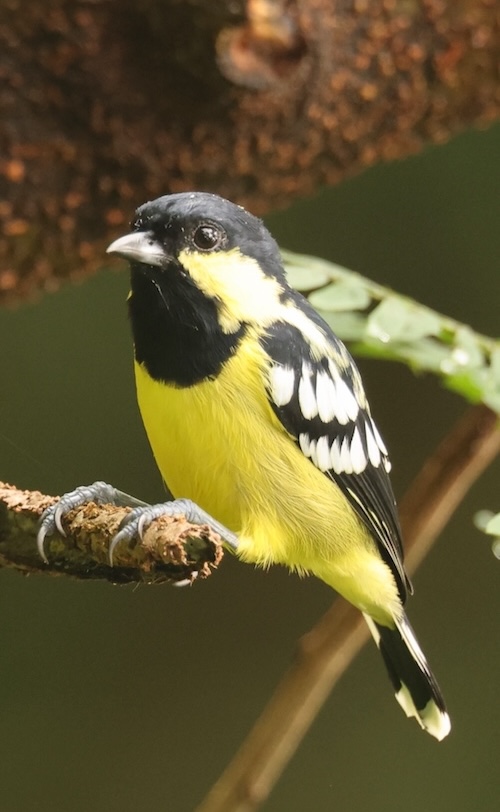Paridae – Tits & Chickadees
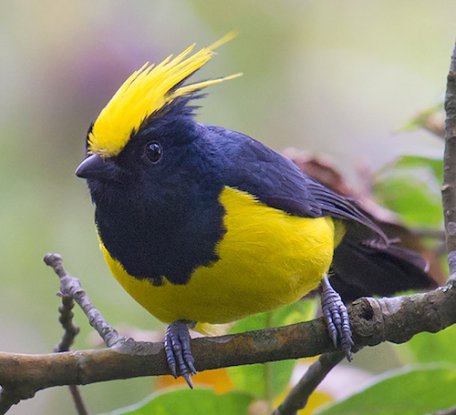
Paridae (Tits, Chickadees & allies) are the feisty acrobats passerines of the bird world. These familiar small songbirds tend to be popular wherever they occur, that is over most of Eurasia, Africa and Northern & Central America. They live in woodland, nesting in holes in trees but foraging for insects and seeds from the canopy down to the ground. These characteristics have allowed many tit species to become common garden birds, using food and nest-boxes provided by humans.
Tits are morphologically well adapted to their life-style. Their short stout bills are capable of tackling tough food items [and delivering painful blows to human fingers]. Those of Great Tits, especially males, become stouter in autumn as they switch from a diet of insects to one of seeds such as beech mast.
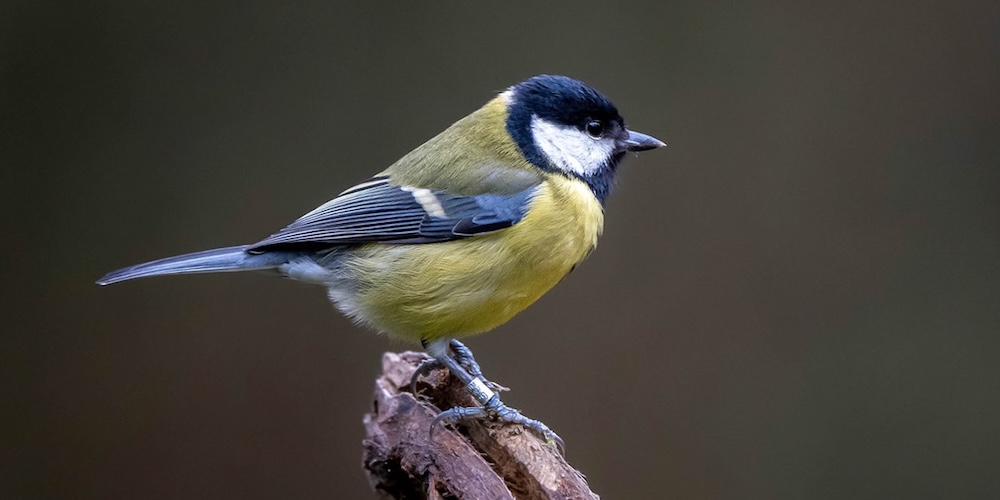
Great Tit Parus major – ©Ashley Beolens
The acrobatic antics of tits are aided by their short but powerful legs. Many, such as Blue Tits, can hang upside down suspended by just one foot. Tits have short wings with rounded tips, ideal for manoeuvrability in dense foliage but less good for speed. Their flight is weak and undulating, and most species are highly sedentary. This feature, combined with their ready use of feeders and nest-boxes, has made abundant species such as Great Tits and Black-capped Chickadees among the most-studied animal species in the world.

Varied Tit Sittiparus varius – ©Craig Brelsford
Most tits are strikingly coloured, often in black and white but sometimes with blues, greens and yellows. A few species are drab, notably the Oak and Juniper Titmice of North America which are clad in shades of grey (titmouse derives from Old Scandinavian tittr for a small thing and Saxon máse for small bird but the plural titmice is now well-established). The sexes are usually similar but distinguishable, with males averaging larger in size and brighter in colour. Juveniles are usually duller and often more yellow in colour than adults.
Although most tits are noisy birds, their territorial songs are usually far from musical. The American name ‘Chickadee’ is an onomatopoeic rendition of common calls of three species [Black-capped, Carolina and Mountain Chickadees].
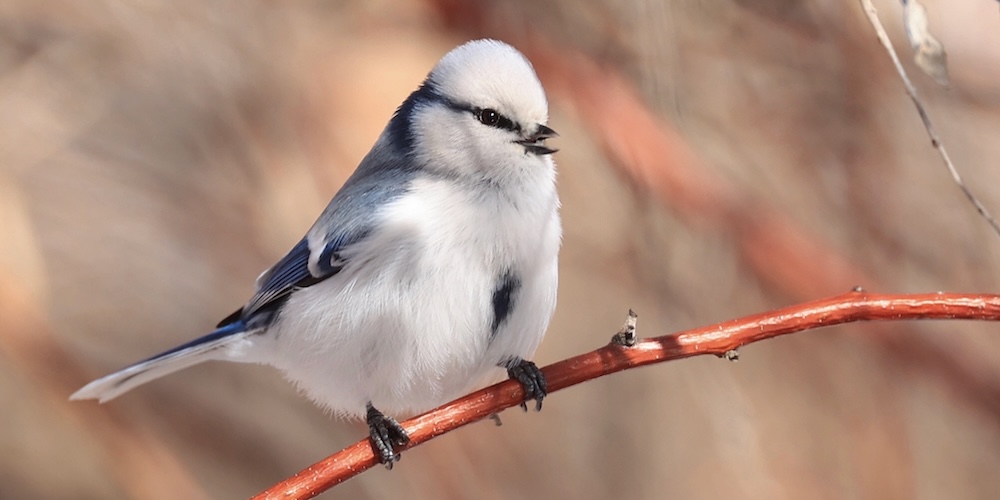
Azure Tit Cyanistes cyanus – ©Nick Ludovic Green Bird-Photo-Tours ASIA
Tits breed as territorial monogamous pairs, with occasional instances of bigamy by males. Most nest in natural holes in trees or holes excavated by other birds, although some [e.g. Willow Tit] excavate their own nests. Any such excavation, and nest building and incubation in all species, is done primarily or only by the female.
|
|
|
|
Rufous-vented Tit Periparus rubidiventris |
Green-backed Tit Parus monticolus |
|
|
|
|
White-browed Tit Poecile superciliosus |
Elegant Tit Periparus elegans |
|
The four photos above courtesy of ©Nick Ludovic Green Bird-Photo-Tours ASIA |
|
Tit eggs are whitish with reddish speckling. Both parents feed the brood, which is usually large. Family parties of tits at the end of the breeding season and winter flocks [which in some species can exceed 100 birds] are often joined by other species. Some species, e.g. Chestnut-backed Chickadee of western North America and White-bellied Tit of East Africa, seem to act as particularly powerful magnets.
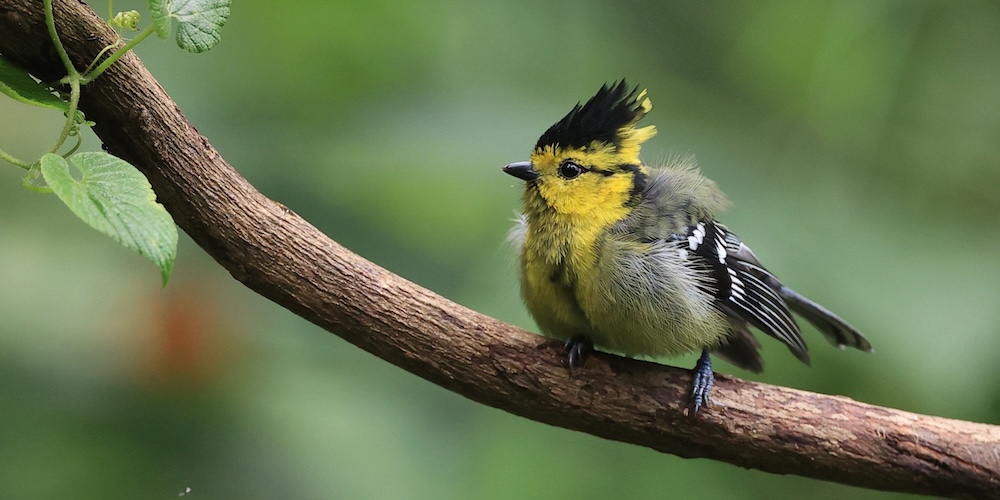
Yellow-cheeked Tit Machlolophus spilonotus – ©Nick Ludovic Green Bird-Photo-Tours ASIA
Until recently, virtually all tits were placed in the same genus, Parus. The two exceptions were two South-East Asian species: the large [nearly Redwing-sized] Sultan Tit with its bright yellow crest, and the Yellow-browed Tit, which looks embarrassingly similar to a leaf warbler until you spot its stubby bill and small crest. A DNA study (1996) rocked the boat by dividing Parus into no fewer than six genera, a change rapidly adopted by the American Ornithologists’ Union but not by all other checklists. In addition, several taxonomic splits have been proposed since, potentially adding ten new species, although some have not been widely accepted. We follow the recently combined AviList, which has taken into account all existing research and opinion and often calls for more DNA research before splitting or lumping further.
-
Number of bird species: 60
(As at December 2025)
According to the recently (2025) amalgamated AviList, there are sixty species, in twelve genera in the Paridae family. They are:
Fire-capped Tit Cephalopyrus flammiceps
Yellow-browed Tit Sylviparus modestus
Sultan Tit Melanochlora sultanea
African Blue Tit Cyanistes teneriffae
Azure Tit Cyanistes cyanus
Eurasian Blue Tit Cyanistes caeruleus
Green-backed Tit Parus monticolus
Great Tit Parus major
Cinereous Tit Parus cinereus
White-naped Tit Machlolophus nuchalis
Yellow Tit Machlolophus holsti
Himalayan Black-lored Tit Machlolophus xanthogenys
Indian Black-lored Tit Machlolophus aplonotus
Yellow-cheeked Tit Machlolophus spilonotus
White-shouldered Black Tit Melaniparus guineensis
White-winged Black Tit Melaniparus leucomelas
Rufous-bellied Tit Melaniparus rufiventris
White-bellied Tit Melaniparus albiventris
Southern Black Tit Melaniparus niger
Carp’s Tit Melaniparus carpi
Dusky Tit Melaniparus funereus
Miombo Tit Melaniparus griseiventris
Stripe-breasted Tit Melaniparus fasciiventer
Acacia Tit Melaniparus thruppi
Red-throated Tit Melaniparus fringillinus
White-backed Black Tit Melaniparus leuconotus
Ashy Tit Melaniparus cinerascens
Grey Tit Melaniparus afer
Yellow-bellied Tit Periparus venustulus
Palawan Tit Periparus amabilis
Elegant Tit Periparus elegans
Coal Tit Periparus ater
Rufous-naped Tit Periparus rufonuchalis
Rufous-vented Tit Periparus rubidiventris
Grey Crested Tit Lophophanes dichrous
European Crested Tit Lophophanes cristatus
Bridled Titmouse Baeolophus wollweberi
Oak Titmouse Baeolophus inornatus
Juniper Titmouse Baeolophus ridgwayi
Tufted Titmouse Baeolophus bicolor
Black-crested Titmouse Baeolophus atricristatus
Chestnut-bellied Tit Sittiparus castaneoventris
Iriomote Tit Sittiparus olivaceus
Varied Tit Sittiparus varius
Owston’s Tit Sittiparus owstoni
White-fronted Tit Sittiparus semilarvatus
White-browed Tit Poecile superciliosus
Sombre Tit Poecile lugubris
Pere David’s Tit Poecile davidi
Marsh Tit Poecile palustris
Caspian Tit Poecile hyrcanus
Black-bibbed Tit Poecile hypermelaenus
Willow Tit Poecile montanus
Grey-headed Chickadee Poecile cinctus
Chestnut-backed Chickadee Poecile rufescens
Boreal Chickadee Poecile hudsonicus
Mountain Chickadee Poecile gambeli
Mexican Chickadee Poecile sclateri
Carolina Chickadee Poecile carolinensis
Black-capped Chickadee Poecile atricapillus
-
Black-Capped Chickadee
| (Wild Bird Guides) by Susan M Smith | Stackpole Books | 1997 | Paperback | 96 pages, 165 colour photos | ISBN: 9780811726863 Buy this book from NHBS.com -
British Tits
| By Christopher M Perrins | HarperCollins | 2009 | Hardback | ISBN: 9780007308408 Buy this book from NHBS.com -
Ecology and Behavior of Chickadees and Titmice - An integrated approach
| By Ken A Otter | OUP | 2007 | Hardback | 319 pages, Figs, tabs | ISBN: 9780198569992 Buy this book from NHBS.com
-
Paridae
Family AccountThese familiar birds of Northern Hemisphere forest habitats have somewhat stouter bills and eat more seeds during the harsh winter months than do many other... -
Paridae
Family AccountThe tits, chickadees, and titmice constitute the Paridae, a family of small passerine birds which occur mainly in the Northern Hemisphere and Africa.
Given the number of species in this family, Fatbirder does not provide quick links to all of them. However, the entries below do include links to representatives of every genera, all those illustrated and some of the most often encountered, iconic or sought-after species.
-
Azure Tit Cyanistes cyanus
Species AccountThe azure tit (Cyanistes cyanus) is a passerine bird in the tit family Paridae. It is a widespread and common resident breeder throughout Russia and central Asia. -
Azure Tit Cyanistes cyanus
Species AccountSound archive and distribution map -
Black-capped Chickadee Poecile atricapilla
Species AccountThis tiny, plump-bodied, big-headed bird is a familiar woodland resident and backyard visitor in the northern US and Canada. -
Black-capped Chickadee Poecile atricapilla
Species AccountThe black-capped chickadee (Poecile atricapillus) is a small, nonmigratory, North American passerine bird that lives in deciduous and mixed forests. -
Black-capped Chickadee Poecile atricapilla
Species AccountSound archive and distribution map. -
Blue Tit Cyanistes caeruleus
Species AccountThe Eurasian blue tit (Cyanistes caeruleus) is a small passerine bird in the tit family, Paridae. It is easily recognised by its blue and yellow plumage and... -
Blue Tit Cyanistes caeruleus
Species AccountSound archive and distribution map. -
Boreal Chickadee Poecile hudsonica
Species AccountThe boreal chickadee (Poecile hudsonicus) is a small passerine songbird in the tit family Paridae. It is found in the boreal forests of Alaska, Canada and the... -
Boreal Chickadee Poecile hudsonica
Species AccountSound archive and distribution map. -
Bridled Titmouse Baeolophus wollweberi
Species AccountThe bridled titmouse (Baeolophus wollweberi) is a small passerine bird in the family Paridae, the tits and chickadees. -
Bridled Titmouse Baeolophus wollweberi
Species AccountSound archive and distribution map. -
Carolina Chickadee Parus carolinensis
Species AccountThe Carolina chickadee (Poecile carolinensis) is a small passerine bird in the tit family Paridae. ... The Carolina chickadee was often placed in the genus Parus... -
Carolina Chickadee Parus carolinensis
Species AccountPoecile carolinensis is listed as Least Concern. -
Carolina Chickadee Parus carolinensis
Species AccountSound archive and distribution map. -
Carp's Tit Melaniparus carpi
Species AccountCarp's tit (Melaniparus carpi) or Carp's black tit, is a species of bird in the family Paridae. -
Carp's Tit Melaniparus carpi
Species AccountSound archive and distribution map -
Coal Tit Periparus ater - UK Status
Species AccountThe coal tit (Periparus ater) is a small passerine bird in the tit family, Paridae. -
Coal Tit Periparus ater - UK Status
Species AccountSound archive and distribution map. -
Crested Tit Lophophanes cristatus
Species AccountThe crested tit or European crested tit (Lophophanes cristatus) is a passerine bird in the tit family Paridae. -
Crested Tit Lophophanes cristatus
Species AccountSound archive and distribution map. -
Elegant Tit Periparus elegans
Species AccountThe elegant tit (Periparus elegans) is a species of bird in the tit family Paridae endemic to the Philippines. -
Elegant Tit Periparus elegans
Species AccountSound archive and distribution map -
Fire-capped Tit Cephalopyrus flammiceps
Species AccountThe species was once considered to be a kinglet but is today treated as a tit. -
Fire-capped Tit Cephalopyrus flammiceps
Species AccountSound archive and distribution map -
Great Tit Parus major
Species AccountThe great tit (Parus major) is a small passerine bird in the tit family Paridae. It is a widespread and common species throughout Europe, the Middle East... -
Great Tit Parus major
Species AccountSound archive and distribution map. -
Green-backed Tit Parus monticolus
Species AccountColorful small songbird of foothill and montane forests (up to 2800 m). -
Green-backed Tit Parus monticolus
Species AccountSound archive and distribution map -
Himalayan Black-lored Tit Machlolophus xanthogenys
Species AccountSound archive and distribution map -
Himalayan Black-lored Tit Machlolophus xanthogenys
Species AccountThe Himalayan black-lored tit (Machlolophus xanthogenys), also known as simply black-lored tit, is a passerine bird in the tit family.../ -
Marsh Tit Parus palustris
Species AccountSound archive and distribution map. -
Marsh Tit Poecile palustris
Species AccountThe marsh tit (Poecile palustris) is a Eurasian passerine bird in the tit family Paridae and genus Poecile, closely related to the willow tit... -
Mexican Chickadee Poecile sclateri
Species AccountThe Mexican chickadee (Poecile sclateri) is a small songbird, a passerine bird in the tit family Paridae. It is still often placed in the genus Parus... -
Mexican Chickadee Poecile sclateri
Species AccountSound archive and distribution map. -
Mountain Chickadee Poecile gambeli
Species AccountThe mountain chickadee (Poecile gambeli) is a small songbird, a passerine bird in the tit family Paridae. -
Mountain Chickadee Poecile gambeli
Species AccountSound archive and distribution map. -
Oak Titmouse Baeolophus inornatus
Species AccountThe oak titmouse (Baeolophus inornatus) is a passerine bird in the tit family Paridae. -
Oak Titmouse Baeolophus inornatus
Species AccountSound archive and distribution map. -
Rufous-vented Tit Periparus rubidiventris
Species AccountThe rufous-vented tit (Periparus rubidiventris) is an Asian songbird species in the tit and chickadee family (Paridae). -
Rufous-vented Tit Periparus rubidiventris
Species AccountSound archive and distribution map -
Siberian Tit (Gray-headed Chickadee) Poecile cincta
Species AccountThe grey-headed chickadee or Siberian tit (Poecile cinctus) is a passerine bird in the tit family Paridae. -
Siberian Tit (Gray-headed Chickadee) Poecile cincta
Species AccountSound archive and distribution map. -
Sombre Tit Poecile lugubris
Species AccountThe sombre tit (Poecile lugubris) is a species of passerine bird belonging to the family Paridae, the "true" tits and chickadees. -
Sombre Tit Poecile lugubris
Species AccountSound archive and distribution map. -
Sultan Tit Melanochlora sultanea
Species AccountThe sultan tit (Melanochlora sultanea) is an Asian forest bird with black upperparts plumage and yellow underparts, dark bill, and (depending on subspecies)..... -
Sultan Tit Melanochlora sultanea
Species AccountSound archive and distribution map -
Tufted Titmouse Baeolophus bicolour
Species AccountThe tufted titmouse (Baeolophus bicolor) is a small songbird native to eastern North America. The species belongs to the tit and chickadee family (Paridae). -
Tufted Titmouse Baeolophus bicolour
Species AccountBaeolophus bicolor is listed as Least Concern. -
Tufted Titmouse Parus bicolor
Species AccountSound archive and distribution map. -
Varied Tit Sittiparus varius
Species AccountThe varied tit (Sittiparus varius) is a perching bird from the tit family, Paridae. It occurs in the eastern Palearctic in Japan, Korea, and locally in... -
Varied Tit Sittiparus varius
Species AccountSound archive and distribution map. -
White-browed Tit Poecile superciliosus
Species AccountThe white-browed tit (Poecile superciliosus) is a species of bird in the tit family Paridae. -
White-browed Tit Poecile superciliosus
Species AccountSound archive and distribution map -
Willow Tit Poecile montana
Species AccountThe willow tit (Poecile montanus) is a passerine bird in the tit family, Paridae. It is a widespread and common resident breeder throughout temperate... -
Willow Tit Poecile montana
Species AccountSound archive and distribution map. -
Yellow-browed Tit Sylviparus modestus
Species AccountThe yellow-browed tit (Sylviparus modestus) is a species of bird in the family Paridae. -
Yellow-browed Tit Sylviparus modestus
Species AccountSound archive and distribution map -
Yellow-cheeked Tit Machlolophus spilonotus
Species AccountThis dashing medium-sized tit can be found in broadleaf and mixed hill forests, as well as adjacent parks and gardens. -
Yellow-cheeked Tit Machlolophus spilonotus
Species AccountSound archive and distribution map
-
Elizabeth & Malcolm's Bluetit Pages
WebsiteIn February 2001 we installed our first bluetit nest box containing a video camera. In 2002 we added a second box and camera and we watched the birds nest building, egg laying, hatching and finally fledging from both nests. These details can be found by clicking on the 2001 or the 2002 links alongside. Again, in 2003 we are monitoring nesting progress in both our boxes. Both pairs of birds have successfully reared chicks in the years we have been watching them. Follow this diary to see if we are as lucky this year. Details can be seen in the 2003 Diary alongside. Hopefully, we will be following them until early June when the chicks leave their nests.

